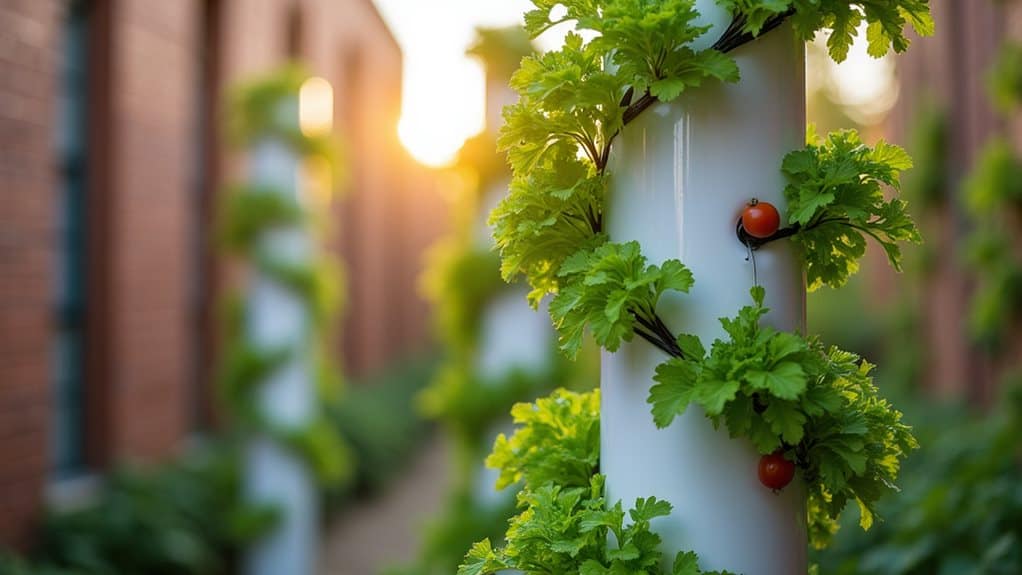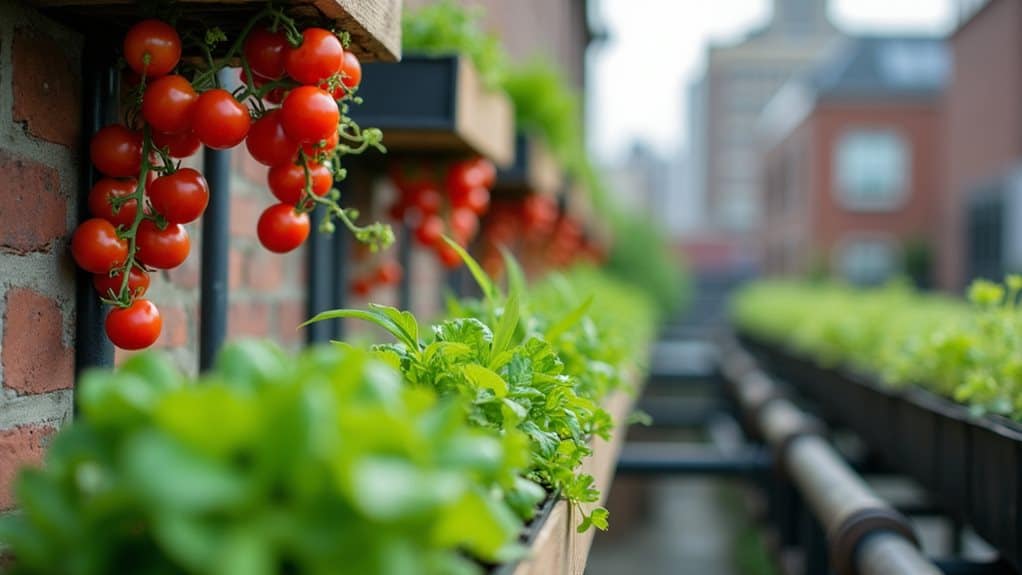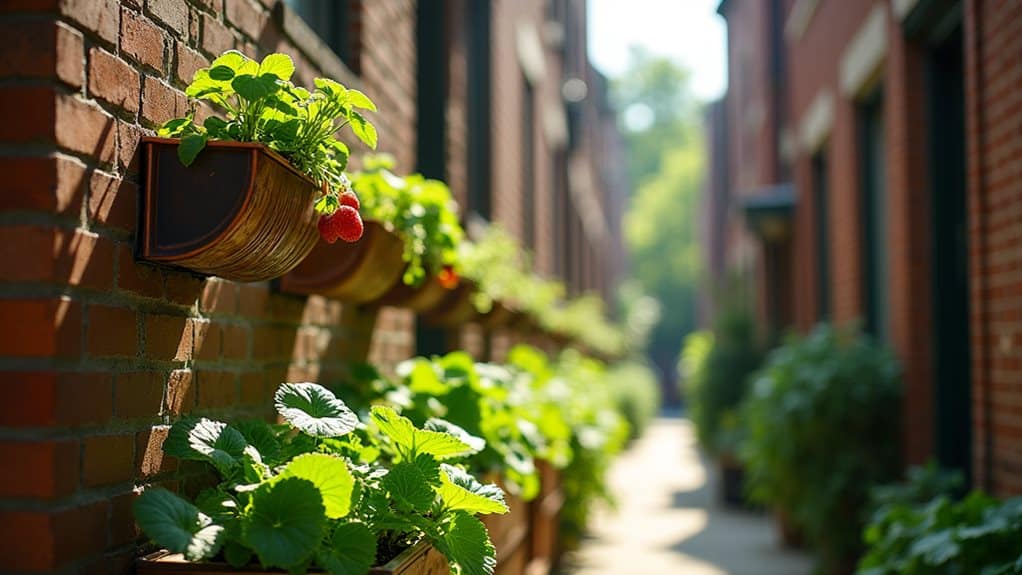Creative Ways to Grow Food in Small Spaces
You can absolutely grow fresh food in tiny spaces using vertical tower gardens that pack 56 plants into just 25 square feet, or try container gardening with lightweight pots you can move around your balcony for perfect sunlight. Indoor LED lighting systems let you cultivate crops year-round, while microgreens and sprouts thrive on countertops with minimal resources – just seeds, water, and shallow trays. These creative techniques will change your cramped apartment into a productive mini-farm that’ll surprise you with possibilities.
Quick Guide
- Tower gardens maximize vertical space by stacking 56 plants in just 25 square feet, perfect for urban environments.
- Container gardening with lightweight pots allows easy repositioning for optimal sunlight and weather protection in small areas.
- Indoor LED lighting systems enable year-round food production in cramped spaces with energy-efficient, full-spectrum illumination.
- Microgreens and sprouts require minimal space, growing quickly in jars or shallow trays without soil requirements.
- Water-efficient hydroponic towers and drip irrigation create closed-loop systems that conserve water while maximizing yield.
Maximizing Vertical Growing Space With Tower Gardens

When you’re dealing with a tiny balcony, cramped patio, or postage-stamp backyard, tower gardens become your secret weapon for turning that limited space into a green oasis that’ll make your neighbors wonder if you’ve unearthed some kind of gardening magic. You can stack 56 plants in just 25 square feet, growing upward instead of outward! Tower gardens maximize growing area in a compact footprint, making them perfect for urban gardeners who want to squeeze every bit of productivity from their available space. Additionally, using a quality potting mix can enhance plant growth and ensure nutrient availability for your tower garden.
Container Gardening Solutions for Balconies and Patios
When you’re ready to change your balcony or patio into a thriving food garden, you’ll want to start with crops that practically grow themselves and won’t leave you scratching your head in confusion.
Think about choosing beginner-friendly plants like cherry tomatoes, lettuce, and herbs that’ll forgive your rookie mistakes while you learn the ropes.
Don’t forget to take into account how much sunlight your space actually gets throughout the day—because trust me, that shady corner you thought was perfect mightn’t be ideal for sun-loving peppers! Make sure to assess sunlight conditions along with wind patterns and available space to ensure you’re selecting the most suitable plants for your specific container garden setup.
You’ll also need containers that you can easily move around to chase the best light or protect your plants from harsh weather, which means selecting lightweight pots that won’t throw out your back every time you need to rearrange your mini farm.
Choosing Beginner-Friendly Crops
Starting your container gardening adventure doesn’t have to feel overwhelming, especially if you pick the right crops that’ll practically grow themselves while you’re learning the ropes!
Cherry tomatoes, bell peppers, and leafy greens like lettuce are your best friends here, offering quick harvests and forgiving growth habits that’ll enhance your confidence faster than you can say “homegrown salad.”
Optimizing Light and Mobility
Since your balcony or patio probably isn’t blessed with the same luxury of space as a sprawling backyard garden, you’ll need to get creative with how you position and move your containers to capture every precious ray of sunlight while making the most of your compact growing area!
Choose lightweight containers with handles or wheeled stands for easy repositioning.
Indoor Growing With Artificial Lighting Systems

Three key lighting technologies can convert any cramped indoor space into a thriving food garden, and you’ll be amazed at how much fresh produce you can grow right inside your home! LED lights deliver energy-efficient, full-spectrum illumination that’ll make your tomatoes think they’re basking in sunshine, while HID and induction systems provide intense lighting for serious indoor harvests. Additionally, ensuring proper airflow management is essential for maintaining plant health under artificial lighting systems.
Microgreens and Sprouts for Countertop Cultivation
When you’re craving fresh, nutrient-packed greens but your kitchen counter is about the size of a postage stamp, microgreens and sprouts become your secret weapon for growing incredible food in impossibly small spaces! You’ll need just a jar for sprouts or shallow trays for microgreens, plus seeds and water—no soil required for sprouting exploits! Consider incorporating Sweet Alyssum in your growing space, as it thrives in various conditions and can attract beneficial insects to your countertop garden.
Integrating Edible Plants Into Home Decor

Who says you can’t have your garden and eat it too, especially when your “garden” becomes the most gorgeous part of your home décor?
You’ll change wire baskets into lettuce planters, hang strawberry cascades from ceilings, and turn windowsills into aromatic herb displays that’ll make your kitchen smell absolutely divine while providing fresh ingredients!
Water-Efficient Systems for Small-Space Agriculture
When you’re growing food in cramped quarters like a tiny apartment balcony or that awkward corner of your patio, managing water becomes just as essential as finding space for your plants – trust me, I learned this the hard way when my first container garden turned into a soggy mess that had my downstairs neighbor knocking on my door!
You’ll want to excel in container drainage management because proper water flow prevents root rot while conserving every precious drop, especially if you’re dealing with water restrictions or simply want to keep your utility bills from skyrocketing.
The cool thing about vertical water conservation techniques is that they let you stack your growing operation upward while creating smart water recycling systems that would make any camping enthusiast proud, since you’re basically creating a closed-loop system that uses gravity and clever engineering to maximize every ounce of H2O.
Container Drainage Management
Three critical elements determine whether your container garden thrives or becomes a soggy disaster: proper drainage, smart watering systems, and the right growing medium that’ll keep your plants’ roots happy and healthy.
You’ll need drainage holes at the bottom—trust me, waterlogged soil kills more plants than forgetting to water them does!
Vertical Water Conservation
While traditional farming guzzles water like a thirsty hiker on a desert trail, vertical water conservation systems flip the script and make every single drop count in your small-space garden!
You’ll slash water usage by up to 90% using drip irrigation and hydroponic towers that recirculate nutrients, creating closed-loop systems that’d make any eco-conscious camper proud!
Choosing the Right Crops for Limited Growing Areas

Since you’re working with limited space, picking the right crops becomes absolutely essential for maximizing your harvest and ensuring you don’t waste precious square footage on plants that won’t thrive in cramped quarters.
Focus on vertical growers like cherry tomatoes, climbing beans, and peas that’ll stretch upward rather than outward, plus fast-yielding radishes and microgreens for quick satisfaction.
Creating Multi-Level Growing Systems With Shelving
When you’ve perfected the art of choosing compact crops, it’s time to think like a skyscraper designer and build your garden upward instead of outward – because who says you need a sprawling backyard when you can create a towering food factory right in your living room or balcony?
Multi-tier shelving systems maximize your vertical space brilliantly!
Wrapping Up
You’ve got everything you need to turn your tiny space into a food-producing powerhouse, and honestly, it’s way more exciting than you might think! Whether you’re stacking tower gardens like green skyscrapers, tucking herbs between your favorite books, or watching sprouts magically appear on your kitchen counter, you’ll be amazed at how much fresh food you can grow. Your small space is about to become your favorite place to hang out!






